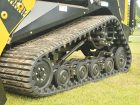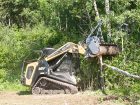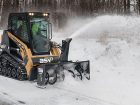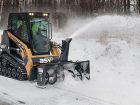
Matching track loaders to your customers’ conditions
By Bill Wake ASV Holdings director of product development
Features Tech tips technologyEveryone loves versatile tools. It’s a big reason why compact track loaders are so popular with today’s contractors, who can use the machines in a wide range of applications and conditions.
 Everyone loves versatile tools.
Everyone loves versatile tools.While all track loaders are able to use different attachments to perform a variety of jobs, they don’t all do so with the same level of performance and efficiency. Because rental stores need their machines to not only be versatile, but also high-performing and efficient, it is important that they look beyond the spec sheet when making their buying decision.
There are a number of points to consider when choosing a compact track loader that can significantly impact productivity and ROI. It’s important to examine basics, such as what the machine will be used for, the types of surfaces it will be used on, ease of maintenance and operator safety and comfort. The best combination of features results in an all-weather, all-application machine.
Is Size a Factor?
Store owners should first consider the jobsites typical for their customers’ work. One common compact track loader application is landscaping where workers often haul material to and from the street and back yard. This requires the unit to work in tight spaces between houses or through gates. Such applications require a machine small enough to quickly and efficiently get where it needs to go. In these situations, it’s not uncommon for landscape contractors to opt for stand-on units that boast compact design and light footprint. However, these units are less efficient and powerful, plus they are often difficult to operate and not nearly as safe as a ride-on unit. Some manufacturers offer machines with a complete operator’s station and in a similar size class with the same durability and reliability as a full-size unit but with a footprint as small as four feet wide and capable of being transported on a standard-sized trailer.
On the other end of the spectrum, the most demanding jobsites require bigger, more powerful machines for large-scale construction and forestry applications. The most powerful machines on the market produce around 360 foot-pounds of torque. A lot of larger machines are sold for applications where high-flow performance is critical. Many manufacturers publish theoretical hydraulic flows and pressures on their spec sheets, but cannot run more demanding attachments entering the market, such as mulching heads and cold planers.
Another important application consideration is whether any lift-and-carry work will be required. Vertical lift designs are best for that type of work, such as handling materials, moving pallets and loading trucks. The radial lift design is the best solution if the primary function is mulching and excavation that requires heavier attachments.
Lifting also requires an examination of lift height and reach requirements. Determine the appropriate height, whether the machine will be doing tasks such as filling dump trucks or placing pallets on high shelves. A lifting height of greater than 10 feet could mean the difference between moving material twice or being able to sort and load with one unit. This can provide for time savings in demolition and recycling applications as well as agricultural applications. Choose a vertical lift machine for a greater forward reach at full lift height.
Make sure the unit works with attachments that fit the type of work it will be doing. Manufacturers design compact track loaders to be attachment drivers. The diversity of attachments leads to higher utilization and more flexibility to complete a variety of jobs. Research what attachment types and sizes the machine will accommodate. This includes looking at the unit’s hydraulic flow rate and the weight of the attachment to match it to the loader specifications. Having a unit that allows for both brush clearing and snow removal allows a store to expand business opportunities and create year-round work.
To maximize torque to the attachment and enhance overall performance, the unit must run at peak efficiency. Rubber track undercarriages reduce friction, improving horsepower efficiency by as much as 10 per cent compared to steel-embedded undercarriages. This is because the engine requires less horsepower to power the tracks, meaning more power is directed to the hydraulic system for powering the attachment.
Demanding applications often require specialized features in order to maximize durability and productivity. A one-machine-fits-all approach simply won’t work. If the typical applications include high debris, rough terrain and difficult surroundings, it’s best to look for a machine purpose-built for those demands. Forestry applications are especially demanding, involving driving over logs and debris with significant amounts of flying material. Forestry-specific or heavy-duty models offer features that enhance comfort, reduce downtime and extend the life of the machine. Several purpose-designed units offer reinforced windows, a full rear brush guard, extra guarding around key machine components, auto-reversing fans to clear the engine compartment screens, or heavy-gauge cabs rated for withstanding falling objects and rollovers.
Forestry and right-of-way work often involves sharp turns and driving across hills, things that frequently cause track derailment on standard track loaders. Choose a model with a large number of lugs and contact points to reduce the chances of derailment when working in such harsh environments.
Track width is also a point to consider. Forestry often means soft and extreme terrain. Look for a wider track for more traction. Some manufacturers offer forestry machines with up to 20-inch-wide tracks. The extra width can mean the difference between completing a job and spending the day getting unstuck.
A demanding environment is more than debris and obstructions. The heavier the attachment and the higher the ambient temperature, the more important it is to have an efficient cooling system to prevent overheating and limit downtime. Look for a machine designed to keep water and oil temperatures in safe operating ranges under 100 per cent load, 100 per cent of the time at temperatures exceeding 118 F. These units can run attachments such as mulchers without the addition of expensive external cooling. Many manufacturers stack the radiator, oil cooler and air conditioning condenser on top of each other. These designs run the same air through multiple coolers, reducing efficiency. For enhanced cooling efficiency, choose a side-by-side radiator and hydraulic oil cooler with a separate A/C condenser. This will prevent debris from trapping between coolers and the warm air from one reducing the efficiency of the other.
Efficient hydraulics and cooling systems can allow a lower horsepower machine to outperform a higher horsepower unit, resulting in more power and lower fuel consumption. It’s important to consider that, though a less efficient cooling system costs less up front, there will still be the price of added cooling systems that are required to perform some of today’s more demanding tasks.
Consider Conditions
Choosing the best machine for a variety of jobs requires identifying the surfaces the unit will most often work on. A compact track loader with excellent ground pressure, flotation, traction and ground clearance is a valuable, all-season machine.
In order to prevent extra costs, landscaping jobs call for equipment that won’t damage delicate turf. This is even more important for work on golf courses’ manicured greens. The lower a unit’s ground pressure, the lower the risk of damage. Rubber track machines have as many as four times more ground contact points in their tracks than steel-embedded models. This spreads the unit’s weight evenly for lower pounds-per-square-inch and extra flotation on delicate surfaces. Look for wider tracks for even lower ground pressure or choose smooth turf tracks as another option to prevent surface damage.
More contact points also means more flotation and traction on steep, slippery and wet ground, giving contractors more control on snow, ice, mud and slush. The additional traction allows for faster and safer work during snow clearing or while driving on a muddy construction site, ranch or farm. Low PSI and good flotation can even give a compact track loader the ability to drive on top of snow or mud without sinking. For example, this allows a farmer to fetch hay bales from the middle of a snow-filled or soggy field without being bogged down.
While turf is a key consideration, obstacles can’t be overlooked. Units without enough ground clearance can get hung up on rocks, logs and other debris.Most compact track loader undercarriages are converted from skidsteer designs, meaning ground clearance is limited to the original wheel height. A machine that is purpose-built from the ground up will maximize ground clearance, providing an average of five inches more than converted designs.
Minimize Downtime
While performance is the key to any machine, maintenance and downtime have a significant impact. Designs that make it easy and convenient to perform regular maintenance enhance utilization and overall efficiency. Most models only offer a rear door to access the engine compartment, which provides limited access for daily tasks, such as checking oil and filters. Some manufacturers build machines with multiple side panels in addition to the rear access. This provides more accessibility and can cut recommended maintenance times in half.
Be sure to consider whether the ground the compact track loader will be driven over includes brush or small abrasive materials that could become trapped in the undercarriage and wear away at components. Steel-embedded undercarriages have a closed design from which material is unlikely to escape and which are difficult to clean. All of the wheels are exposed in rubber track undercarriages, allowing material to easily spill out.
Think of the Operator
Having a year-round machine means year-round work. This makes operator comfort and ease of use extremely important when selecting a new compact track loader. One of the first things to consider when looking at operator comfort is the type of machine suspension. There are several types on the market, but most are rigid-mounted. This means that when the unit hits an obstacle, the end wheels will not flex, which can jar the operator. For more comfort, look for a dual-level suspension. These include two torsion axles to suspend each track frame in addition to a second level of suspension allowing the bogey wheels to flex and maximize ground contact. This provides a smoother ride and improves traction.
Watch for additional ease-of-use and comfort-focused features in the machine’s cab. Small comforts can mean a lot to operators who spend hours in a compact track loader. Sealed-in glass side walls and corners provide easy visibility in all directions leading to an overall safer worksite. In addition, AC and heating vents distributed throughout the cab for even temperature allow for a pressurized, all-weather cab. Other comfort features include cup holders, a cell phone tray, an adjustable lap bar and joystick, and a USB charging port. Some new models even have hands-free Bluetooth cell phone systems so the operator can take calls while operating the machine. This means the opportunity to multitask doesn’t stop while in the cab and safety is maintained.
Keeping Track
Selecting the best compact track loader for the job goes far beyond the list price and spec sheet. Pay attention to the range of applications and seasons a new machine can excel in, operator comfort, serviceability, efficiency and ROI.
The large variety of compact track loaders on the market means there are machines that not only meet rental stores’ needs but also open the door to new applications due to their versatility. Look carefully before choosing a common, one-size-fits-all model. A smart choice results in a compact track loader that’s not only versatile, but also features the high performance and efficiency to finish jobs faster, better and with minimal downtime.
About ASV
ASV Holdings Inc., a publicly traded company on NASDAQ, designs and manufactures a full line of compact track and skid-steer loaders primarily for the construction and forestry markets. Located in Grand Rapids, Minn., ASV Holdings Inc. was formed from ASV LLC, a joint venture between Manitex International Inc. and Terex Inc. The manufacturer originated as ASV Inc., a company that was started in 1983 and was one of the pioneers in the compact track loader industry. ASV designs and manufactures compact track loaders and skid steers under the ASV brand. ASV builds its compact track loaders using unique and patented Posi-Track undercarriage technology that provides exceptional traction on soft, wet, slippery, rough or hilly terrain.
Compact equipment manufacturers
by Canadian Rental Service
The following list of skidsteer and track loader OEMs serving the Canadian rental industry was taken from Canadian Rental Service Buyers Guide listings and is not intended to be comprehensive. Contact the manufacturer or visit their website to find the dealer serving your area.
ASV
800-205-9913
Grand Rapids, Minn.
asvllc.com
Bobcat
701-241-8700
West Fargo, N.D.
bobcat.com
Boxer Equipment/Morbark
800-831-0042
Winn, Mi.
morbark.com
Caterpillar
888-614-4328
Peoria, Ill.
caterpillar.com
Case Construction Equipment
905-791-3131
Toronto, Ont.
strongco.com
Ditch Witch
800-654-6481
Perry, Okla.
ditchwitch.com
John Deere
844-809-1508
Moline, Ill.
deere.ca
Kubota
800-405-6916
Markham, Ont.
kubota.ca
Manitou
262-334-9461
West Bend, Wis.
manitou.com
Takeuchi
706-693-3633
Pendergrass. Ga.
takeuchi-us.com
Toro
800-888-9926
Bloomington, Minn.
toro.com
Wacker Neuson
Toronto: 905-795-1661
Calgary: 403-255-3336
ca.wackerneuson.com
Print this page



